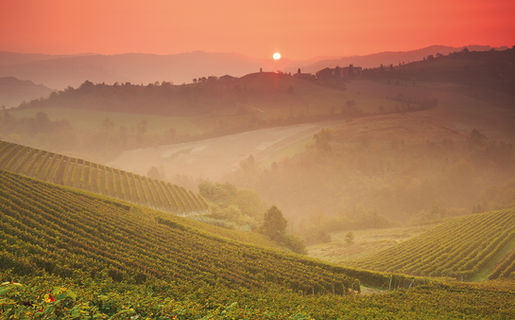Wines
March 25, 2020 – Published in Design & Decor Spring 2017 issue
Barolo – does it measure up to its hype?
Words Albert Cilia-Vincenti
Barolo and Barbaresco are the two top exponents of the Nebbiolo grape, which gets its name from nebbia (mist) because the hilly regions of Piedmont are often bathed in mist and fog. When the sun gets through, this north-western region of Italy offers great natural beauty, apart from food and wine, and has been recently elevated to world heritage site status.
Nebbiolo is extremely sensitive to differences in soil and microclimate, yet pinpointing typicity between Barolo and Barbaresco is not easy. Barbaresco is said to be lighter and softer, but differences within Barolo can be as great as differences between Barolo and Barbaresco. Within Barolo, Serralunga is the latest-ripening commune while La Morra is the earliest. Serralunga wines are said to be among the weightiest, and does of La Morra are silky and appealing when young. Castiglione Falletto is said to make concentrated wines of great finesse.
Barolo’s reputation as one of Italy’s top reds is not easy to appreciate. Some say the Nebbiolo grape is at odds with its reputation. As with red Burgundy, Barolo is difficult to approach and come to terms with. As a sweeping statement, Barolos tend to be expensive, tannic and acidic. They are said to need at least 10 years bottle-age to reveal a haunting scent and complex flavours, but many examples will unfortunately disappoint. Young winemakers have tried to modernise Barolo to produce softer more forward wines that keep their tannic rasp while hopefully offering a rose petal scent, black chocolate and prunes richness and tarry intensity, but they are in danger of finishing up on the international new-oaked, vanilla-scented, superstar heap.
The classic description of Nebbiolo’s scent is tar and roses – sounds an improbable combination, but then Nebbiolo is an improbable grape, combining high levels of tannin and acidity and (in its best examples) some of the most complex, exotic scents to be found in any red wine. To tar and roses one might add cherries, mulberries, leather, fresh and dried herbs, spice, liquorice and dried fruit. There is a certain austerity about Barolo and Barbaresco, though this is less common from modernist producers where the fruit is fresher and rounded out by ageing or with new oak barrique fermentation. Even in traditionalist examples, mature Barolo should be supple. It is a pity if Barolo or Barbaresco smells strongly of new oak vanilla – any wine from anywhere can do this. But only Nebbiolo has that much sought-after (not uncommonly in vain) haunting aroma and, to mask it with add-on scents, is to lose the point of the wine (and its price) completely.
Our “Il-Qatra” wine club blind-tasted four Barolos by 39 of our members during dinner at Xara Palace. Marcarini’s Brunate 2008, La Morra (14%; €40) was the membership’s overall 1st preference, slightly ahead of the overall 2nd preference, the Palladino Parafada 2012, Serralunga d’Alba (14.5%; €29). I scored these two equally in 2nd place, noting a faint sweetish plumy nose and a mainly mild tannic and acidic palate in the Marcarini, while I thought the Palladino had a faint sweetish nose but later both its nose and palate were rather dour and finally tannic and acidic.
Interestingly the membership’s overall 3rd preference was Cavallotto’s Vignolo 2007, Castiglione Falletto (14.5%; €70), which I scored my 1st preference, noting it had the best nose, although faint but plumy, and a delicate sweet palate with fine tannins, mild acidity and good length. I agreed with the overall scoring and placed Palladino’s San Bernardo 2010, Serralunga d’Alba (14%; €29) well down to 4th preference noting only an unremarkable nose and palate.
The still white wine aperitif served was an Fontanabianca’s Arneis Langhe 2015, Neive (13.5%; €10). Xara Palace’s highly regarded kitchen did not disappoint.
acvincenti@gmail.com








